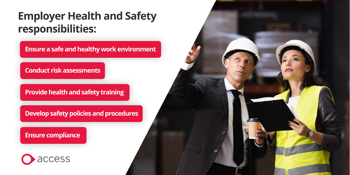Who is responsible for health and safety in the workplace?
In the UK, the employer is legally responsible for health and safety at work, although there is also a wider responsibility for employees to ensure a safe working environment.
To help you to better understand the general duties and responsibilities of employers and employees, we’ve put together this guide. In it, we’ll cover the health and safety responsibilities of employees as well as employers, and explain how the Health & Safety Act applies to your business.
5 employer health & safety responsibilities
In the UK, it’s predominantly the employer who is responsible for enforcing health and safety in the workplace. However, everyone is responsible for ensuring a safe working environment to minimise risks and improve conditions for employees and members of the public.
There are five core health and safety responsibilities for employers, each of which covers a variety of essential considerations that must be taken into account. Let’s explore these in more detail:
1. Ensure a safe and healthy work environment
It’s important that employers create and maintain a work environment that is free from hazards to ensure the physical and mental wellbeing of their employees. The specifics of what this means will vary depending on your industry and the type of work that employees carry out. However, this could include ensuring adequate lighting and ventilation, providing safety equipment and ergonomic workspaces, promoting health and safety best practices, and addressing any work-related health concerns promptly.
2. Conduct risk assessments
Carrying out risk assessments is essential in order to identify and evaluate potential hazards that could cause harm to employees and members of the public. Employers should conduct risk assessments annually at a minimum, as well as whenever there are significant changes to the workplace. Risk assessments may also be required on an ad-hoc basis, such as at the start of a construction project or when planning a public event.
3. Provide health and safety training
Providing health and safety training is crucial to ensure that employees are aware of potential hazards, the policies in place to mitigate them, and how to follow these policies to ensure a safe working environment. To support the health and safety responsibilities of employees, employers must offer regular health and safety training courses covering relevant safety procedures, emergency protocols and proper use of equipment.
4. Develop safety policies and procedures
Developing comprehensive health and safety policies and procedures is essential, as it helps your organisation to ensure a consistent approach to safe working practices. These documents should detail the responsibilities of employees and management, emergency procedures, guidelines for safe working practices and, where relevant, information regarding UK laws and regulations.
Ensure that all safety policies and procedures are accessible for all employees and updated on a regular basis.
5. Ensure compliance
Along with generic health and safety requirements, different industries will have their own specific legal requirements to adhere to. It’s the employer’s responsibility to ensure that their organisation’s health and safety policies are in line with all relevant legislation, and that they’re regularly reviewed and updated as necessary. This involves carrying out regular audits, keeping accurate records, and promptly addressing any non-compliance issues, and could include the appointment of a health and safety officer, who is responsible for health and safety inspections.

Why is it a legal responsibility to the employer?
According to the Health and Safety at Work etc Act 1974 (HSWA), it’s the employer who is legally responsible for health and safety at work. This legislation states that it’s “the duty of every employer to ensure, so far as is reasonably practicable, the health, safety and welfare at work of all his employees.”
Failure to adhere to relevant laws and legislations regarding health and safety in the workplace could lead to legal issues, including fines and potential lawsuits should an employer become ill or sustain an injury. This not only poses a financial risk but also damages the company’s reputation and undermines employee trust.
What are the health and safety responsibilities of employees?
Although it’s the employer who is legally responsible for health and safety at work, individual employees are all responsible for ensuring their own safety, as well as the safety of those around them.
The HSWA also outlines the responsibilities of employees, stating that they must “take reasonable care for the health and safety of himself and of other persons who may be affected by his acts or omissions at work.”
It’s essential that employees not only understand what their health and safety responsibilities are, but why they’re in place, and what may happen if they fail to uphold them.
The health and safety responsibilities of employees include:
- Ensuring that they understand all health and safety procedures outlined to them by their employer
- Following all health and safety procedures at all times
- Completing health and safety training as required
- Reporting any accidents, hazards or failings in safety procedures
- Complying with employers to enable the accurate carrying out of risk assessments
- Being proactive and using common sense with regards to health and safety in the workplace
Schedule your personalised demo of our Health and Safety training courses today!
Workplace health and safety roles and responsibilities
Most larger businesses will have dedicated health and safety staff, who are responsible for enforcing health and safety in the workplace. Although smaller businesses may not have the resources available to create a specific team, they still have a legal obligation to ensure the wellbeing of their staff, and compliance with all relevant legislation for their industry.
Different roles in the health and safety department include health and safety manager, health and safety officer, safety coordinator, risk manager, and environmental health and safety (EHS) specialist. These individuals are responsible for ensuring that the organisation meets its health and safety obligations, which includes ensuring that all practices align with the five core responsibilities we looked at above.
Responsibilities of health and safety staff include:
- Conducting regular risk assessments to identify potential hazards
- Developing and implementing strategies to mitigate identified risks
- Creating comprehensive health and safety policies in line with regulatory requirements
- Organising health and safety training sessions for employees
- Investigating and reporting on any workplace incidents to determine causes and preventive measures
- Ensuring that the organisation complies with all relevant health and safety regulations
- Performing regular health and safety audits and reporting findings to management
Who is responsible for health and safety inspections?
Health and safety managers are typically responsible for conducting regular inspections to ensure compliance with regulations. UK health and safety regulations and identify potential hazards.
Who is responsible for risk assessments?
Health and safety officers are usually responsible for carrying out risk assessments in the workplace. They identify risks, evaluate their potential impact, and develop strategies to mitigate them in line with UK regulations.
Enhance your workplace health & safety with training
As we’ve seen in this guide, it’s primarily the employer who is responsible for health and safety in the workplace. To meet your responsibilities as an employer, it’s important to provide adequate health and safety training to employees. As well as helping your organisation to remain compliant, this ensures that employees are equipped with the information they need to perform their roles safely and mitigate risks.
eLearning is a powerful tool that can help employers to deliver health and safety training quickly and easily to employees both on site and remotely. Using a dedicated eLearning platform also allows managers and health and safety professionals to track progress and identify areas of knowledge that are lacking.
Take a look at the health and safety training courses we have available, or download our brochure to see how The Access Group can support your business.

Drive a safety culture with Access Learning

Speak to an expert
Chat with one of our learning experts and find out how our Health and Safety courses can help your organisation remain safe and compliant.

Schedule a live demo
Explore the features, functionality and benefits Health and Safety courses has to offer and ask questions to our learning experts.


